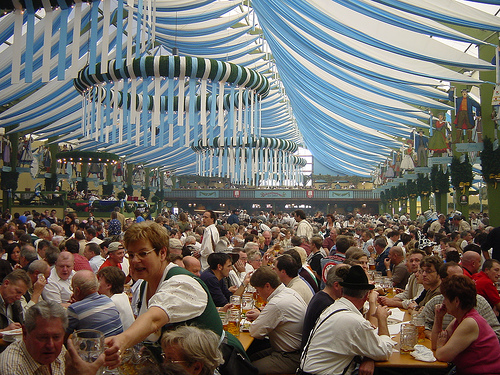
the Oktoberfest a grand occasion
It all started with a "yes". On 12 October 1810 Crown Prince Ludwig of Bavaria (the future King Ludwig I) and Princess Therese of Saxony-Hildburghausen exchanged their marriage vows, thus kicking off a mega-bash that culminated five days later with a spirited horse race. The party was such a rip-roaring success that the Munich magistrate decided that it warranted an annual repeat performance.
Over time, many other traditions were added. Carnival booths appeared in 1816, the folk costume and riflemen's parade followed in 1835, while the brewers first paraded in 1887. And since 1950, the Oktoberfest has officially opened with the tapping of the first keg by the Munich mayor.
And so it was again this year. At noon on 18 September 2010, Mayor Christian Ude launched the world's biggest collective drink-up with the magic words: O'zapft ist! (It is tapped!). For the next 17 days, more than six million normally prim and sober citizens from every country in the world will descend upon the Theresienwiese festival grounds (Wiesn, for short) to guzzle towering mugs of beer and engage in good cheer and outright debauchery. This year is the 200th anniversary of the tankard-clinking marathon and the city of Munich has come up with some unique ways to mark the occasion.
For a primer on the Oktoberfest, report to the Münchner Stadtmuseum (Munich City Museum; www.stadtmuseum-online.de), where a special exhibit tracks its evolution from Bavarian royal wedding gala to beery extravaganza. There are plenty of fun displays, like the oldest beer keg, an epic painting that graced the festival entrance on the 100th anniversary, and fancy dirndl (traditional women's dress) designs through the ages.

Raise your stein and say "Prost!" during Oktoberfest at the Theresienwiese fairgrounds in Munich
Also special this year is the "Historical Wiesn", a small camp set up on the southern edge of the grounds. Here you can take a trip back in time as riflemen, costume groups and oompah bands entertain visitors with traditional dance and song. Historical rides and amusements are showcased in the museum tent, while a theatre tent presents political satire, comedy and folk music. And even the horse racing tradition, which officially ended in 1960, will be temporarily revived on the adjacent racetrack.
But do not worry, all the familiar Oktoberfest trappings will still be there as well. You will find yourself in the midst of a sensory assault as you soak up the aroma of roast chicken and bratwurst, pick out a colourful gingerbread heart to take home to your loved ones and avert your gaze from the pimply-faced teen who has had one beer too many. Yes, that too is part of Oktoberfest tradition. And so are the amusements, from high-tech rollercoasters to nostalgic charmers like Schichtl's famous fake beheadings and the flea circus where trained pests provide the oomph for miniature chariots that outweigh them a thousand-fold.
The biggest lures are naturally the big beer tents where local businessmen in lederhosen hoist mugs with bearded mountain folk and giddy Italian tourists. Interestingly, each tent has a different vibe. The Hofbräuhaus is the biggest and especially popular with tourists. Older locals prefer the more traditional Augustiner, while Schottenhamel gets more of a younger crowd. The flirt factor is through the roof at Hippodrom and Käfer Wies'n-Schänke, which attracts lots of singles and even the occasional celebrity.
Top five Oktoberfest tips
1. Beer tents are elbow-to-elbow all day on Saturday and Sunday, so try a weekday afternoon for lighter traffic. Until Thursday of the first week, evenings are less swamped too.
2. Last call at all the big beer tents is at 10.30 pm, one hour before closing time. Leave no later than 10 pm to avoid unruly masses staggering to the bus and train stations.
3. An Oktoberfest brew is always served in a 1L tankard called a Mass. Before drinking, it is crucial that you say "Prost" and clink your mug while making eye contact with everyone at the table.
4. Cash is king at Oktoberfest, so stop by an ATM back in town to avoid the exorbitant fees charged at those on the festival grounds. Frustrate pickpockets by putting your valuables inside a money belt.
5. Save money by visiting on "family days" (21 and 28 September from noon to 6pm, 4 October 10am to 3pm). On weekends from 10am to 3pm, rides, stalls and restaurants sporting the sign "Mittagswiesn" also offer discounts.